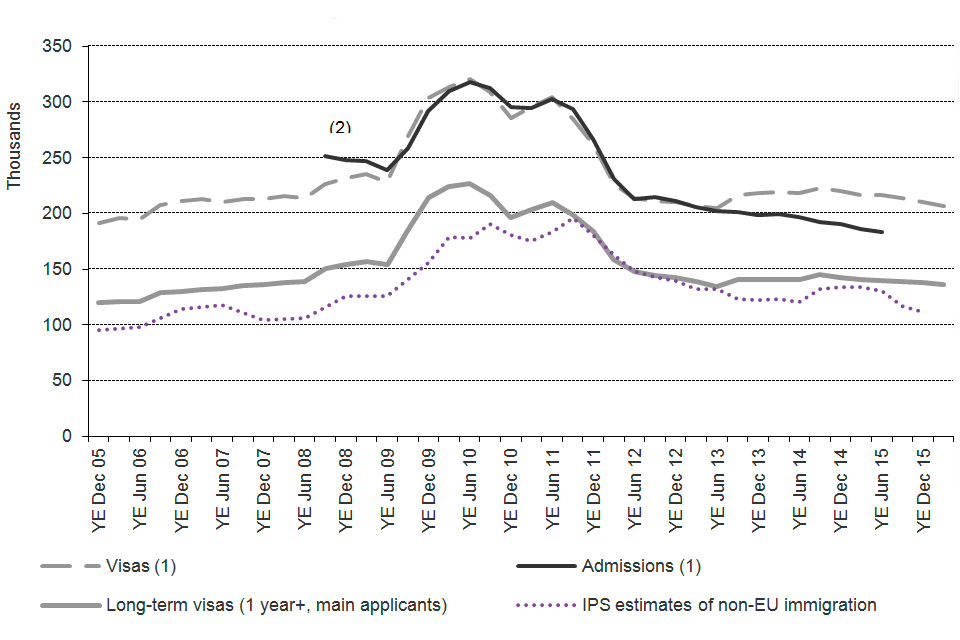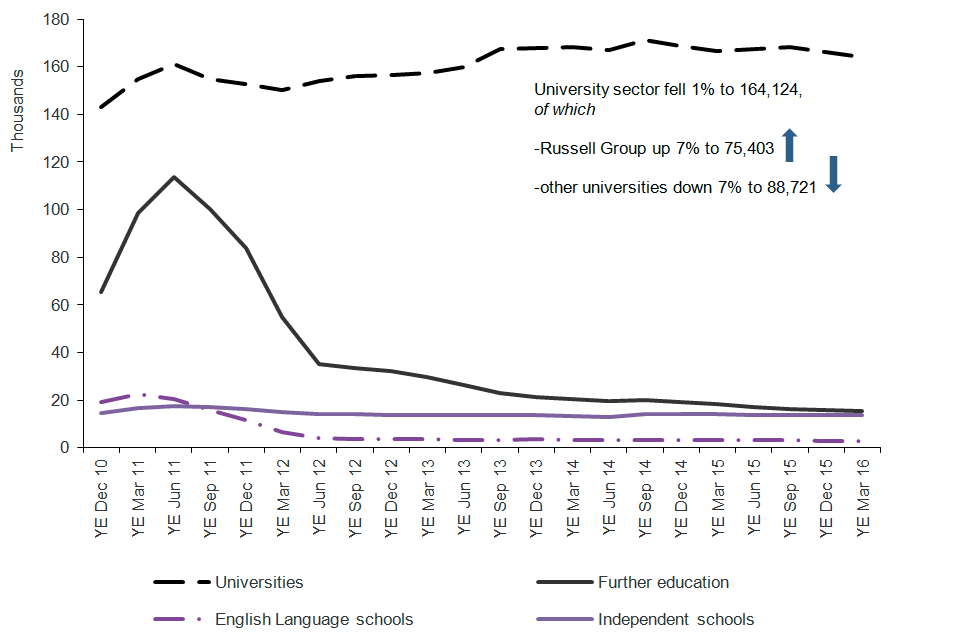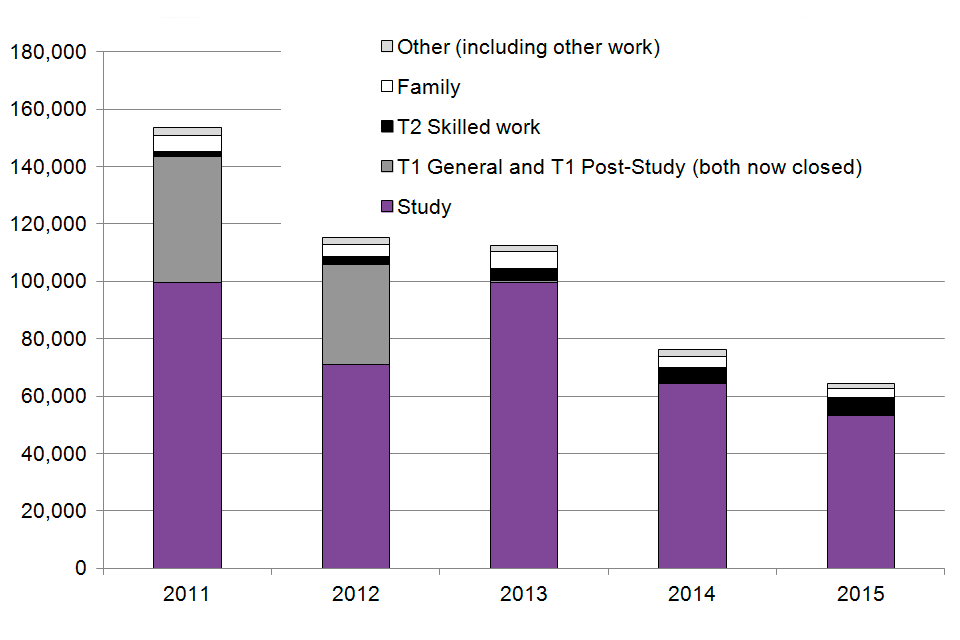Study
Updated 26 May 2016
Valid: 26 May 2016 to 24 August 2016
Data relate to the year ending March 2016 and all comparisons are with the year ending March 2015, unless indicated otherwise.
Back to ‘Immigration statistics January to March 2016’ content page.
This is not the latest release. View latest release.
1. Key facts
In the year ending March 2016, there were 206,162 Study-related visas granted, excluding the unsponsored short-term student category (formerly known as ‘student visitors’), a reduction of 5% (-10,210). Over the same period, the number of university-sponsored study visa applications (main applicants) fell slightly (-1% to 164,124). However, there was a 7% increase for Russell Group universities to 75,403. There were also falls for the Further Education (-15% to 15,507), English Language schools (-20% to 2,669) and Independent school (-3% to 13,591) sectors. Most of the fall in the Further Education sector’s sponsored visa applications since the peak in mid-2011 was accounted for by licenses which have since been revoked.
In the year ending December 2015, the ONS estimates that there were 112,000 non-EU long-term immigrants coming to study and who had an intention to remain a year or more, a 16% (-22,000) fall, which is statistically significant. Over the same period, the number of long-term (1 year or more) study-related visas granted (main applicants) was 4% lower at 137,506. Although the trends in the long-term estimates and comparable visa numbers can differ they are fairly close given the definitional differences and the inherent variation in the ONS survey based estimates.
In the year ending December 2015, ONS also estimates that the number of non-EU former students who were long-term emigrants from the UK had fallen to 42,000, although the change was not statistically significant.
Five non-EU nationalities accounted for 55% of the 206,162 study visas granted in the year ending March 2016, with the largest number going to Chinese nationals (70,515 or 34% of the total). Over the year ending March 2016, there were higher numbers of study visas granted, excluding the unsponsored short-term student category (formerly known as ‘student visitors’) for Chinese (+6,038 or +9%), Egyptian (+371; +29%) and Indonesian (+330; +14%) nationals; and fewer Iraqi (-2,241; -73%), Nigerian (-2,234; -20%), and Libyan (-2,195; -73%) nationals.
Study-related grants of extensions fell by over a fifth (-21%) to 58,205 in the year ending March 2016. Corresponding sponsored applications data (main applicants) showed a 23% fall, much of the drop accounted for by a fall of over two-thirds in the Further Education sector. These trends are likely to reflect previous falls in the visas granted and tightening of the rules such as the new use of the “genuineness” test from October 2013.
The Migrant journey: sixth report indicated that, based on data matching, around one sixth (17%) of migrants issued a study visa in 2009 still had valid leave to remain in the UK or had been granted settlement 5 years later. This proportion has decreased over time from 24% of those issued a study visa in 2004.
2. Study immigration: latest trends
| Year ending March 2015 | Year ending March 2016 | Change | Percentage change | |
|---|---|---|---|---|
| Study-related visas granted excluding short-term students (1) | 216,372 | 206,162 | -10,210 | -5% |
| of which (Top 5): | ||||
| China | 64,477 | 70,515 | +6,038 | +9% |
| United States | 14,076 | 13,970 | -106 | -1% |
| India | 12,097 | 10,705 | -1,392 | -12% |
| Malaysia | 10,719 | 9,563 | -1,156 | -11% |
| Hong Kong | 9,387 | 9,021 | -366 | -4% |
| Short-term study visas (1) (main applicants only) | 68,770 | 64,798 | -3,972 | -6% |
| Year ending December 2014 | Year ending December 2015 | Change | Percentage change | |
| Long-term immigration for study excluding dependants (2) | 134,000 | 112,000 | -22,000 | -16% |
| Long-term (1 year or more) study-related visas excluding dependants | 142,513 | 137,506 | -5,007 | -4% |
Table notes
Source: Home Office, Immigration Statistics January to March 2016 Visas table vi 04 q, Visas table vi 06 q s, International Passenger Survey, Office for National Statistics Migration Statistics Quarterly Report.
(1) The Short-term study category (previously described as ‘student visitor’) allows individuals to come to the UK for 6 months (or 11 months if they will be studying an English Language course) and cannot extend their stay (further details at Short-term study visa ). For consistency and comparability over time Short-term study visas have been excluded from study-related totals.
(2) Immigration for study data are estimates of the number of non-EU nationals intending to change their residence to the UK for at least 12 months based on the International Passenger Survey.
3. Long-term trends in student immigration

The chart shows the trends for study of visas granted, admissions and International Passenger Survey (IPS) estimates of non-EU immigration, between 2005 and the latest data published. Sourced from Tables vi 04 q, ad 02 q and corresponding datasets.
Chart notes
Source: Home Office, Immigration Statistics January to March 2016, Visas table vi 04 q (Visas volume 1), Admissions table ad 02 q and corresponding datasets; Office for National Statistics, Population and migration.
(1) Excludes ‘short-term students’ (previously referred to as ‘student visitors’) who are allowed to come to the UK for 6 months (or 11 months if they will be studying an English Language course) and cannot extend their stay. A proportion of Tier 4 student visas are also short-term (under 1 year), see ‘Entry clearance visas by length’ but are not included within the ‘short term students’ category.
(2) Prior to the year ending September 2008, the count of student admissions is not comparable as there was no specific admissions category for ‘short-term students’ (previously referred to as ‘student visitors’) who may then have been recorded as either students or visitors.
The above chart shows that IPS long-term immigration estimates, while being substantially lower as they cover only those intending to remain a year or more, follow a broadly similar trend to student visas granted and passenger arrivals.
There are a range of potential reasons why IPS figures for long-term migrants may be different from figures for study visas granted or passenger arrivals, and hence why the trends in the different series do not match, including:
- sampling variation in the IPS (for example, the fall of 22,000 in study-related immigration for the year ending December 2015 had an estimated confidence interval of +/-21,000)
- IPS data for study relate to individuals whose main reason for migration was study so (unlike visas data) are likely to exclude their dependants. IPS data are likely to be more comparable with visa totals for main applicants than with the total for all study-related visas (e.g. including dependants)
- differences between intentions and visa length
- individuals may migrate for multiple different reasons
- timing differences between when visas are granted and when an individual actually travels
- visa and admissions data include dependants, and both short-term and long-term migrants
Further comparison of the data is described in the ONS publication ‘International student migration - what do the statistics tell us?’ (PDF 619Kb) and the user guide.
4. Register of sponsoring educational institutions
On 31 March 2016, there were 1,383 educational institutions on the UK Visas and Immigration register of sponsoring educational institutions. This was 1% lower than the number on 4 January 2016 (1,404), and 10% lower than a year earlier (31 March 2015, 1,543) which continues the reduction in numbers seen since the published series began in October 2011 (2,370). The long-term reduction in the number of sponsoring educational institutions is consistent with the introduction of new accreditation criteria and conditions of status for educational sponsors from April 2011.
5. Sponsored study visa applications by education sector
The number of study-related sponsored visa applications (main applicants) fell 3% in the year ending March 2016 to 198,485, compared with the previous 12 months (205,127). There was a small fall in sponsored visa applications for the university sector as a whole (to 164,124; -1%), but this included a 7% increase for Russell Group universities to 75,403 and a 7% decrease for other universities to 88,721. There were also falls in the Further Education (to 15,507, -15%), English Language schools (to 2,669, -20%) and Independent school (to 13,591; -3%) sectors.
Study-related sponsored visa applications by sector

Shows the trends in confirmations of acceptance of studies used in applications for visas by education sector since 2010 to the latest data available. University sector fell 1% to 164,124. The chart is based on data in Table cs 09 q.
Chart notes
Source: Home Office, Immigration Statistics January to March 2016, Sponsorship table cs 09 q.
‘Universities’ relate to UK-based Higher Education Institutions.
‘Further education’ relates to tertiary, further education or other colleges.
5.1 New entrants to UK Higher Education
In separate statistics published by the Higher Education Statistics Authority (HESA), it has been previously reported that between the 2013/14 and 2014/15 academic years the number of non-EU new entrants to universities decreased by 3% (to 174,305 students). There was no significant change in the number of UK new entrants (756,595), whilst other EU new entrants increased by 1% (to 57,815) in the same year. Over the last five years, comparing 2014/15 with 2009/10, the number of non-EU students has increased by 8% and there have been falls of 21% and 10% for UK and other EU students respectively (Source: HESA), ‘Higher Education Student Enrolments and Qualifications Obtained at Higher Education Providers in the United Kingdom 2014/15’.
6. Immigration for study, and emigration of former students
In the year ending December 2015, the ONS estimates that there were 112,000 non-EU long-term immigrants coming to study and who had an intention to remain a year or more, an 16% (-22,000) fall, statistically significant compared with the previous 12 months.
By contrast, in the year ending December 2015, ONS also estimates that the number of non-EU former students who were long-term emigrants from the UK had fallen to 42,000, although this was not a statistically significant decrease from 44,000 in the previous 12 months.
These estimates will be based on different cohorts of students, but they suggest that currently the level of long-term immigration of non-EU students is around 70,000 higher than the numbers of former long-term students who are leaving the country.
Source: ONS, International Passenger Survey, Migration Statistics Quarterly Report.
7. Extensions of stay
Study-related grants of extensions fell by over a fifth (-21%) to 58,205 in the year ending March 2016, compared with the previous 12 months (73,511). This followed a fall from 140,342 in the year ending March 2011 to 102,110 in the year ending March 2014. The 58,205 extensions included 560 grants under the Tier 4 Doctorate Extension Scheme introduced on 6 April 2013.
The fall in grants of extensions of stay is likely to reflect previous falls in the numbers granted visas, particularly to applicants in further education, together with tightening of the rules such as the new use of the ‘genuineness’ test for study (Tier 4) extensions of stay, announced on 6 September 2013, Statement of Changes in Immigration Rules.
Looking at individuals’ previous category, an estimated 64,483 former students (main applicants) were granted extensions in 2015 (the latest available data for this analysis), compared with 76,175 for 2014. Of the extensions granted in 2015, the majority (83%) allowed individuals to continue to study. There has been a fall in the number of students allowed to switch into a work category from 46,875 in 2011 to 7,226 in 2015 which largely reflects the closure of the Post-Study route. Conversely, the number of students allowed to switch into Tier 2 skilled work has increased from 1,730 in 2011 to 6,004 in 2015.
Extensions granted to former students (by current category of grant) 2011 to 2015 (main applicants)

The chart shows the trends in extensions of stay for former students by previous category. The chart is based on data in Table expc 01 and expc 01 w.
Chart notes
Source: Home Office, Immigration Statistics January to March 2016, Extensions tables expc 01 and expc 01 w.
Note that ‘short-term students’ are normally only allowed to stay for up to 6 months (11 months for English Language schools) and cannot extend their stay.
The number of study-related sponsored applications for extensions (main applicants) fell by 23% (-15,330) to 52,026. Much of the 15,330 drop was accounted for by a fall of over two-thirds (-71%; or -8,607) in the “Other” sector (includes further education institutions and English language schools). There were also falls for universities (-12%; or -6,362 and Independent schools (-25%; or -361).
8. ‘Short-term students’
The ‘short-term student’ category (previously referred to as ‘student visitors’) includes significant numbers admitted for up to 6 months as non-visa nationals without a visa. Visas are granted for a maximum of 6 months in duration or in a very small number of cases for 11 months if studying an English Language course. ‘Short-term students’ are not counted as long-term migrants and cannot extend their stay, so they are not included within the references to study visas in this section. Additionally some students in the study category (Tier 4 of the Points Based System) have short-term visas (under 1 year), see ‘Entry clearance visas by length’ but are not included within the ‘short term students’ category.
There were 279,000 ‘short-term student’ admissions in the calendar year 2014, much higher than the numbers of student visitor visas granted (73,607 over the same period). This is due to many student visitor admissions being from nationalities who are not required to obtain a visa if they wish to come to the UK as a short-term student for up to a maximum of 6 months. For example the non-visa countries of US, Brazil, and Japan accounted for 121,000, 19,100 and 17,200 respectively of the 279,000 student visitors admitted to the UK in 2014.
The number of ‘short-term student’ visas granted fell by 6% to 64,798 in the year ending 2016, after previously having doubled from 37,703 in 2009 to 77,601 in 2013. For further information on short-term students see Short-term study visa and the Home Office research report ‘Student visitors’.
9. Staying on in the UK
Analysis of administrative records for migrants granted visas in 2009 have been published in the Migrant Journey Sixth Report and this shows that around one sixth (17%) of migrants issued a study visa in 2009 still had valid leave to remain in the UK or had been granted settlement 5 years later. This proportion has decreased from 24% of those issued a study visa in 2004.
The proportion of migrants who gained settlement within 5 years of entering on a study visa also declined over the same period. For people issued a study visa in 2004, 3% had gained settlement 5 years later, compared with just 1% of those issued a study visa in 2009.
These changes are consistent with the tightening of the Immigration Rules for students since September 2007. They may also be partly related to the economic recession that occurred towards the end of the period analysed here, which may have reduced the incentive for students to remain and seek work in the UK. The study group reported on here excludes student visitor visas that cannot be extended and normally only have validity of 6 months or in some cases up to 11 months.
Source: Home Office, Migrant journey: sixth report.
10. Data tables
Data on student immigration, sourced from Home Office administrative systems, can be found in the following tables:
Sponsorship: tables cs 07 q to cs 14 q
Visas vol. 1: tables vi 01 q, vi 04 and v1 04 q
vi 01 q Entry clearance visa applications and resolution by category
vi 04 Entry clearance visas granted by category
vi 04 q Entry clearance visas granted by category
Visas vol. 3: tables vi 06 q s
vi 06 q s Entry clearance visas granted by category and country of nationality: Study
Admissions: tables ad 02 to ad 03 and ad 03 s
Extensions: Tables ex 01 to ex 02 s
Provisional estimates of long-term immigration for formal study from the ONS International Passenger Survey (IPS) relate to those whose main reason for migration is formal study and so are likely to exclude dependants (who would be more likely to say their main reason was to ‘accompany or join’ rather than formal study). ONS data is published at Migration Statistics Quarterly Report.
The Higher Education Statistics Agency publishes data on new entrants to UK Higher Education providers..
11. Background information
This section includes figures on study-related visas granted, passenger arrivals and extensions granted for non-EEA nationals. It also includes figures on long-term immigration to study (i.e. those intending to stay for at least 12 months to study) for non-EU nationals.
Data include dependants as well as main applicants unless stated otherwise. Estimates of long-term immigration for study from the ONS International Passenger Survey (IPS) relate to those whose main reason for migration is to study and so are likely to exclude dependants (who would be more likely to say their main reason was to ‘accompany or join’ rather than to study). All comparisons are with the previous 12 months unless indicated.
